Interview
Shadows, Boxes, Forks, and “POAMs”
Fourth in a series of interviews with poets who collect things.
Introduction
Is there a connection between someone's poems and their obsessions? Richard Siken interviews Thylias Moss about her collection of reflections, shadows, and forks. The fourth in an occasional series.
Thylias Moss is the author of eight books of poems, including Tokyo Butter: Poems and Slave Moth: A Narrative in Verse. She lives in Ann Arbor, Michigan.
Richard Siken: Why and what do you collect?
Thylias Moss: I have always collected; collecting is essential to making. The primary location of the collection that I pull from is the wonderful galleries in my brain where I store information. My senses are the tools I use to gather things for these cranial galleries, which I constantly shuffle and reassemble as I make connections. When I find some new entity, some new element, my brain is instantaneously figuring out where to place it.
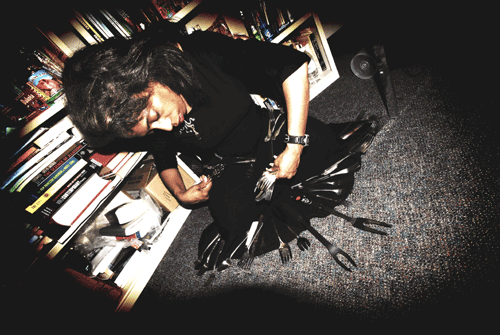
Do you have any viewable, external collections?
In my office I have books on bookshelves, of course, but with them—and this reveals the kind of significance I can attach to that which honestly is completely insignificant—I have lots of sculptured edible junk: stuff that can be eaten, but probably shouldn’t be. My trophy is bubble gum that is the size of a compact disc, and even comes in a compact disc case. It is Christina Aguilera bubble gum. A pink, nonplayable CD.
I have also been collecting forks. I have about a hundred in my office and hundreds more at home. I especially like the forks that I have found where there is considerable evidence of use, such as those with tines that have become skewed or altered in some other way that deviates from their manufactured intention.
And I collect boxes, especially boxes that are more intricately designed—puzzle boxes, and boxes within boxes. I especially like those that invite a journey of investigation so that I can explore ideas of enclosure and scale. I am interested in the idea of going into something to which the entrance has been partially blocked or delayed. You must put forth some effort to enter that space. And I’m interested that a box can contain something larger than itself.
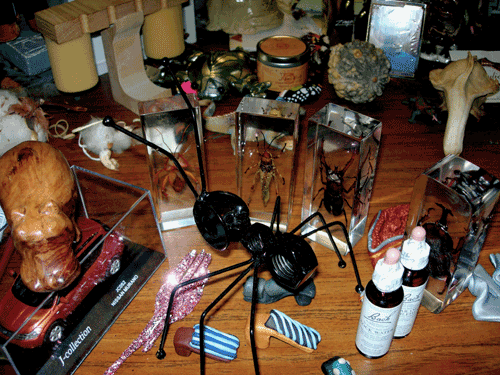
I’ve heard that you collect shadows as well.
I do. I collect shadows and reflections. They interest me because they are collaborations, they exist because of interactions. Light and solid objects meet, and the shadows and the reflections are outcomes of these meetings. It is easier to collect these with film. I have both still and moving collections, and I often pull items from this collection in constructing various video POAMs, or Products Of Acts of Making. These may be seen in my podcasts, which are another type of gallery, galleries where the public can view, experience, and hear what I have saved. The public can also capture [things] and put them in their own collections. I’m fascinated that these devices allow us to take with us visual and sonic things that we consider indispensable and do not want to be caught anywhere without. That individuals refuse to leave the house without them, that’s just fantastic.
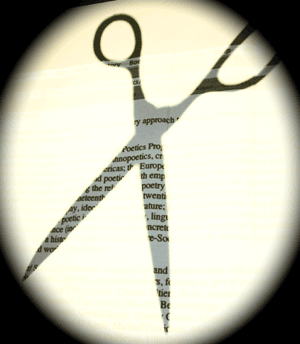
Most of your collections hinge on the idea of transformation, of taking in and letting out—edibles, forks, boxes, and filmed interactions. How important is transformation to your collecting?
Transformation, in some way, must be the purpose. As human beings, we perceive that we are moving forward in time. It seems that we are in transit towards something that could be better and certainly different than what we are now. My emphasis on transformation could be a response to questioning where are we going, what we might become, what are we changing into, step by step on our odyssey to some ultimate form, whatever that might be.
Some of this exploration comes out of my own restlessness. I have a very short attention span. I suppose that I am also just curious. What would happen if this bends, if this twists, where might I be instead, where might this lead? Maybe I just cannot manage a sustained commitment to one way of being or looking. Maybe a singular approach is frightening to me when I think in terms of “lifetime.” Maybe I’m just afraid to collect one thing, so I surround myself with many materials out of which to build things. That is what I do. I take materials and construct other things, other hosts, other houses for ideas and possibilities.
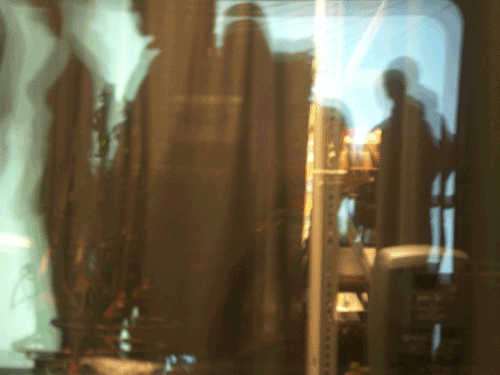
Why collect stuff? When do you give in to the impulse to collect?
The importance of collecting has to do with the transience of experience. Everything is changing, but on different scales. Some change is imperceptible; some things seem permanent relative to the impermanence of human existence. One reason I collect is to respond to this transience. I grab what I can in an attempt to create a kind of parallel existence to it. At the moment in which I collect an item, I take it out of its context and create a version that becomes the record of it. Its form within the collection is not the form in which it will always exist, but the form that has been saved and compiled. In doing this, I am recognizing in the piece a common language. It is saying something that I can interpret in a way that has value, so much so that I surround myself with these things and they become a buffer between me and the world. Collecting is a way of acknowledging and preserving these transitory stations of our existence in flux.
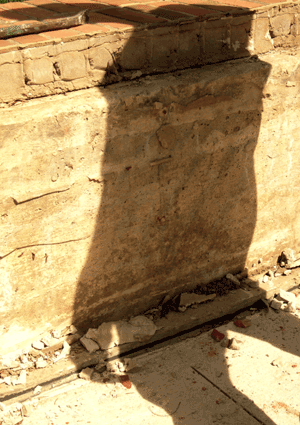
There seems to be considerable overlap between your collections and your poetics. Was it a realization or a decision to combine them?
As I stated, we are moving in a direction that we perceive as forward, suggesting that we are seeking something. I am definitely seeking things to comment about, things that can be the subject or the context of the poems. I reached a point where I needed to question the vehicle of my search. Surely there were other vehicles; I wondered why I was not taking advantage of the new ways to search that technology made possible. I looked at various kinetic possibilities—kinetic forms of typography. If motion is how we acquire information and also the way in which we experience existence, then I needed to seek ways to make that were sensitive to that.
There was a moment in 2004 when the part of me that was interested in sciences and the part of me that makes language-based things out of my experience converged, and I became a maker as opposed to a poet per se, poet just being one strand that contributes to being a maker. I know when this happened. It was October of 2004, when I was at the Quality Sixteen Cinema with my husband. What a moment there in the still-darkened theater, watching the credits. The convergence came as some kind of comet that grazed me with this quickly fading illumination. I said, aloud, “The credits are moving!”
I now had a context, a purpose, and a way for exploring movement within a language system. I set out to study interactions among language systems—among the visual, the sonic, the olfactory, and the tactile. I now had a reason for making differently, not just to say, “Oh, what are the ways in which we can animate text?” I could explore the nature of interactions on every scale, and this has transformed every component of poetry and other things as well. Now I have more reason and more urgency to capture things that are in flux.
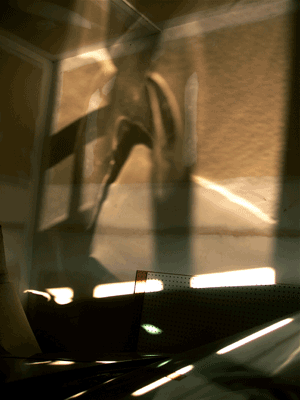
So I suppose you’ll never be done with your collection.
If collecting is locked into my sense of making existence valuable, I hope that I could never finish. I hope that I will retain an interest in finding value for the rest of my life. It is a most cruel obsession, for there is no ending. And yet there must be. The implication is that the collecting will end when I do, when I have changed form. But what I have collected will participate in some other way, perhaps no longer actively as a bounded, identified, classified collection.
So an idea of finishing is very hard for me to comprehend. Does finishing mean something is perfect and needs nothing else? Does finishing mean being exhausted, because I no longer have interest in it? It sounds as if I’m a person who is trying, through collecting and making, to defy the idea that we are heading toward something that will finish. I am, in a way, building an arsenal of antidotes to a notion of the finite, while at the same time moving toward that which is finite.
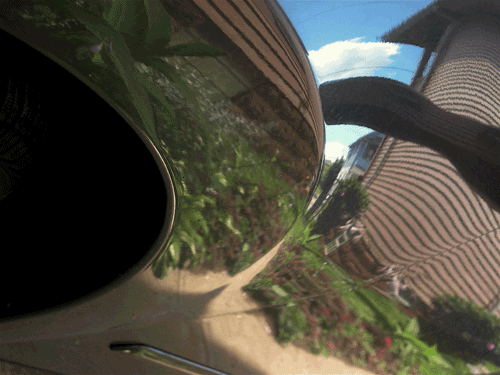
Image of Thylias with forks by Ansted Moss. All other photos by Thylias Moss.
Richard Siken: Why and what do you collect?
Thylias Moss: I have always collected; collecting is essential to making. The primary location of the collection that I pull from is the wonderful galleries in my brain where I store information. My senses are the tools I use to gather things for these cranial galleries, which I constantly shuffle and reassemble as I make connections. When I find some new entity, some new element, my brain is instantaneously figuring out where to place it.

Do you have any viewable, external collections?
In my office I have books on bookshelves, of course, but with them—and this reveals the kind of significance I can attach to that which honestly is completely insignificant—I have lots of sculptured edible junk: stuff that can be eaten, but probably shouldn’t be. My trophy is bubble gum that is the size of a compact disc, and even comes in a compact disc case. It is Christina Aguilera bubble gum. A pink, nonplayable CD.
I have also been collecting forks. I have about a hundred in my office and hundreds more at home. I especially like the forks that I have found where there is considerable evidence of use, such as those with tines that have become skewed or altered in some other way that deviates from their manufactured intention.
And I collect boxes, especially boxes that are more intricately designed—puzzle boxes, and boxes within boxes. I especially like those that invite a journey of investigation so that I can explore ideas of enclosure and scale. I am interested in the idea of going into something to which the entrance has been partially blocked or delayed. You must put forth some effort to enter that space. And I’m interested that a box can contain something larger than itself.

I’ve heard that you collect shadows as well.
I do. I collect shadows and reflections. They interest me because they are collaborations, they exist because of interactions. Light and solid objects meet, and the shadows and the reflections are outcomes of these meetings. It is easier to collect these with film. I have both still and moving collections, and I often pull items from this collection in constructing various video POAMs, or Products Of Acts of Making. These may be seen in my podcasts, which are another type of gallery, galleries where the public can view, experience, and hear what I have saved. The public can also capture [things] and put them in their own collections. I’m fascinated that these devices allow us to take with us visual and sonic things that we consider indispensable and do not want to be caught anywhere without. That individuals refuse to leave the house without them, that’s just fantastic.

Most of your collections hinge on the idea of transformation, of taking in and letting out—edibles, forks, boxes, and filmed interactions. How important is transformation to your collecting?
Transformation, in some way, must be the purpose. As human beings, we perceive that we are moving forward in time. It seems that we are in transit towards something that could be better and certainly different than what we are now. My emphasis on transformation could be a response to questioning where are we going, what we might become, what are we changing into, step by step on our odyssey to some ultimate form, whatever that might be.
Some of this exploration comes out of my own restlessness. I have a very short attention span. I suppose that I am also just curious. What would happen if this bends, if this twists, where might I be instead, where might this lead? Maybe I just cannot manage a sustained commitment to one way of being or looking. Maybe a singular approach is frightening to me when I think in terms of “lifetime.” Maybe I’m just afraid to collect one thing, so I surround myself with many materials out of which to build things. That is what I do. I take materials and construct other things, other hosts, other houses for ideas and possibilities.

Why collect stuff? When do you give in to the impulse to collect?
The importance of collecting has to do with the transience of experience. Everything is changing, but on different scales. Some change is imperceptible; some things seem permanent relative to the impermanence of human existence. One reason I collect is to respond to this transience. I grab what I can in an attempt to create a kind of parallel existence to it. At the moment in which I collect an item, I take it out of its context and create a version that becomes the record of it. Its form within the collection is not the form in which it will always exist, but the form that has been saved and compiled. In doing this, I am recognizing in the piece a common language. It is saying something that I can interpret in a way that has value, so much so that I surround myself with these things and they become a buffer between me and the world. Collecting is a way of acknowledging and preserving these transitory stations of our existence in flux.

There seems to be considerable overlap between your collections and your poetics. Was it a realization or a decision to combine them?
As I stated, we are moving in a direction that we perceive as forward, suggesting that we are seeking something. I am definitely seeking things to comment about, things that can be the subject or the context of the poems. I reached a point where I needed to question the vehicle of my search. Surely there were other vehicles; I wondered why I was not taking advantage of the new ways to search that technology made possible. I looked at various kinetic possibilities—kinetic forms of typography. If motion is how we acquire information and also the way in which we experience existence, then I needed to seek ways to make that were sensitive to that.
There was a moment in 2004 when the part of me that was interested in sciences and the part of me that makes language-based things out of my experience converged, and I became a maker as opposed to a poet per se, poet just being one strand that contributes to being a maker. I know when this happened. It was October of 2004, when I was at the Quality Sixteen Cinema with my husband. What a moment there in the still-darkened theater, watching the credits. The convergence came as some kind of comet that grazed me with this quickly fading illumination. I said, aloud, “The credits are moving!”
I now had a context, a purpose, and a way for exploring movement within a language system. I set out to study interactions among language systems—among the visual, the sonic, the olfactory, and the tactile. I now had a reason for making differently, not just to say, “Oh, what are the ways in which we can animate text?” I could explore the nature of interactions on every scale, and this has transformed every component of poetry and other things as well. Now I have more reason and more urgency to capture things that are in flux.

So I suppose you’ll never be done with your collection.
If collecting is locked into my sense of making existence valuable, I hope that I could never finish. I hope that I will retain an interest in finding value for the rest of my life. It is a most cruel obsession, for there is no ending. And yet there must be. The implication is that the collecting will end when I do, when I have changed form. But what I have collected will participate in some other way, perhaps no longer actively as a bounded, identified, classified collection.
So an idea of finishing is very hard for me to comprehend. Does finishing mean something is perfect and needs nothing else? Does finishing mean being exhausted, because I no longer have interest in it? It sounds as if I’m a person who is trying, through collecting and making, to defy the idea that we are heading toward something that will finish. I am, in a way, building an arsenal of antidotes to a notion of the finite, while at the same time moving toward that which is finite.

Image of Thylias with forks by Ansted Moss. All other photos by Thylias Moss.
Richard Siken is a poet, painter, and filmmaker. His book Crush (Yale University Press, 2005) won the 2004 Yale Series of Younger Poets prize, a Lambda Literary Award, and a Thom Gunn Award. It was also a finalist for the National Book Critics Circle Award. His other books include War of the Foxes (Copper Canyon Press, 2015). Siken has received a Pushcart Prize, two Lannan residencies, two Arizona...


